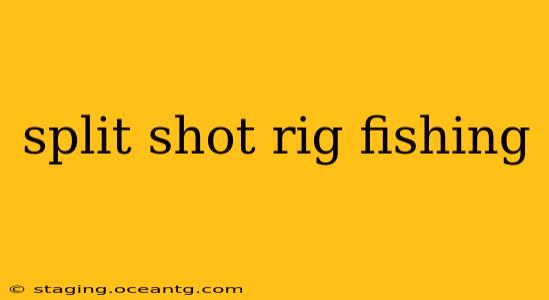The split shot rig is a simple yet incredibly effective fishing technique, perfect for anglers of all skill levels. Its versatility allows you to target a wide variety of fish species in diverse environments. This guide will delve into the intricacies of the split shot rig, covering everything from its setup to advanced applications, answering common questions anglers often have.
What is a Split Shot Rig?
The split shot rig is a simple fishing setup consisting of a fishing line, a hook, and one or more split shot weights. The split shot weights are pinched onto the line above the hook, allowing you to adjust the weight and presentation of your bait or lure. This setup is incredibly effective for presenting your offering subtly, allowing it to drift naturally in the current or along the bottom.
What are Split Shots Used For?
Split shots are small, easily-pinched-on weights used primarily in lighter tackle fishing scenarios. Their versatility makes them ideal for a wide array of applications including:
- Adding weight to light lines: Prevent line sag and keep your bait or lure at the desired depth.
- Controlling bait presentation: Allows for precise control over the speed and depth of your offering.
- Targeting specific depths: Adjusting the weight and placement of the split shot allows you to fish at various depths.
- Fishing in various currents: Effectively counteracts current to keep your bait in the strike zone.
How to Set Up a Split Shot Rig?
Setting up a split shot rig is remarkably simple. Follow these steps:
- Choose your line: Select a lightweight line appropriate for your target species and fishing conditions.
- Attach the hook: Tie your hook to the end of your line using a suitable knot like a Palomar knot or improved clinch knot.
- Attach your bait: Carefully bait your hook with live bait, artificial lures, or other bait.
- Add split shots: Pinch one or more split shots onto your line, above the hook, leaving sufficient space for your bait or lure to move naturally. The distance from the hook to the split shot(s) will depend on the depth you're fishing and the type of current. Experiment to find what works best.
How Far Above the Hook Should I Place the Split Shot?
This depends heavily on the depth you're fishing and the current. In slow currents, placing the split shot 12-18 inches above the hook is often sufficient. In faster currents, you may need to move the split shot closer to the hook, or add more split shots to maintain control. Experimentation is key!
What Size Split Shot Should I Use?
The size of the split shot depends on the weight of your line, the depth you’re fishing, and the current conditions. Start with smaller split shots and increase the size or quantity as needed to maintain proper bait presentation. Remember, the goal is not to bury the bait, but to control its movement.
What Types of Fish Can I Catch Using a Split Shot Rig?
The split shot rig is remarkably versatile and can be used to target a wide range of fish species, including but not limited to:
- Panfish: Bluegill, sunfish, crappie
- Trout: Brook trout, rainbow trout, brown trout
- Bass: Smallmouth bass, largemouth bass (smaller sizes)
- Other species: Various other species depending on location and bait
What Kind of Bait Works Best with a Split Shot Rig?
Almost any bait can be used with a split shot rig. Popular choices include:
- Worms: Nightcrawlers, redworms, earthworms
- Insects: Grasshoppers, crickets
- Small minnows: Live or artificial
- PowerBait: Various scents and colors
What are the Advantages of Using a Split Shot Rig?
The split shot rig offers numerous advantages:
- Simplicity: Easy to set up and use.
- Versatility: Effective in a variety of fishing conditions.
- Sensitivity: Allows for delicate presentations.
- Cost-effectiveness: Relatively inexpensive components.
Conclusion:
The split shot rig is a foundational fishing technique that deserves a place in every angler's arsenal. Its simplicity and versatility make it ideal for beginners and experts alike. By understanding the principles discussed in this guide, you'll be well-equipped to effectively target a wide range of fish species and enjoy a successful fishing experience. Remember, practice and experimentation are key to mastering any fishing technique!
